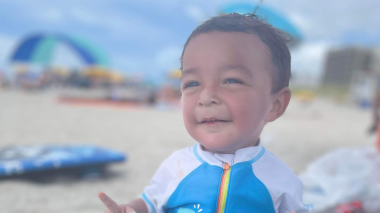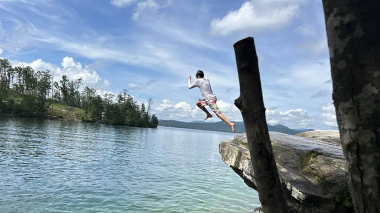As the weather warms up, many children and adolescents are returning to team sports. But while an increase in sports can lead to more activity (and lots of fun!), it can also mean more injuries.
An important first step to ensure your child's safety when participating in sports is to consider scheduling a physical with your child's pediatrician. when scheduling with Atrium Health Levine Children's, your pediatrician can help identify any underlying medical issues that may impact your child's physical activity and work to create a safe plan for getting active.
According to Jeffrey Ham, DO, assistant professor of orthopedics and family medicine at Atrium Health, there are lots of ways parents and coaches can make sure kids stay healthy and injury-free while playing sports. Dr. Ham practices sports medicine and family medicine at Atrium Health Musculoskeletal Institute Orthopedics and Sports Medicine in Lincolnton. He is an expert in musculoskeletal issues, focusing on non-operative sports medicine, and takes care of a wide array of sports-related medical issues.
Q. What are the some of the most common injuries that you and your colleagues see in young athletes? Are there any injuries that parents and coaches should especially watch out for in youth athletics, and with specific sports in particular?
A. When it comes to sports injuries, children and adolescents are different from adults because of growth rates and the growth plates themselves being a point of weakness. The most common things we see are concussions, pediatric fractures of the growth plates, and overuse injuries. We also see a good deal of stress fractures, especially in the lumbar spine, as well as in the hips and the patella. Additionally, we see osteochondrosis, where the growth cartilage actually starts separating from the bone itself due to overuse. Most pediatric injuries are secondary to overuse. Of course, we see heat-related illnesses as well, especially in North Carolina in the summer.
When it comes to sports-specific injuries, here are some of the most common ones:
- Baseball: We see “Little League shoulder” and “Little League elbow” in young pitchers from throwing too much.
- Basketball: One of the biggest concerns is cardiac issues. We’ll also see injuries in the lower extremities, like “jumper’s knee” (an irritation of the growth plate in the kneecap area). Girls who play basketball are more likely to tear their ACL.
- Gymnastics: Wrist injuries are common. Some gymnasts’ wrists go into extension so much that it causes growth arrest, and that can lead to debilitating pain.
- Other sports: In sports like track and field, swimming, and dance (as well as gymnastics), we see children taking in less energy than they should or putting out more energy than they should. This can disrupt the menstrual cycle and lead to an increased risk of osteoporosis (a condition that causes bones to become weak and brittle and can eventually lead to fractures).
Q. Do you have any tips for parents and coaches about preventing common sports injuries?
A. Some of the top ways to prevent common sports injuries in children and adolescents include:
- Free play: Children should be active not just in organized sports, but also just playing outside. Free play helps kids not only from an injury prevention standpoint, but it helps them with developing friends, it helps them with social skills, and it helps them learn new skills that they would not have learned when just learning how to swing a baseball bat or throw a baseball.
- Time off: Children should have 1-2 days off each week from sports (games and practices) and some downtime during the year so the child isn’t playing the same sport all 12 months. According to the American Academy of Pediatrics, young athletes participating in more hours of sport each week than their age in years are at increased risk of suffering a serious overuse injury. Children can also burn out on sports when they overtrain, and that can lead to them giving up on sports entirely. We want them to enjoy sports and stay active for the rest of their lives.
- Strength training: Strength training can prevent lower extremity injuries, and has been shown to prevent some upper extremity injuries as well. Children can start strength training whenever the child is mature enough to pay attention and follow directions. In the pre-pubescent period, it's not so much about making muscles bigger, it's about being able to use those muscles better.
- Helmets: Helmets don’t fully prevent concussions, but they do decrease the risk of catastrophic head injuries. In football, we used to see a lot of players putting the crown of their heads down, which put their necks in vulnerable positions; this led to a lot of cervical fractures, but now we don’t see that as much. In soccer, one thing that I really stress is not allowing any heading of the ball until a child is at least 12 years of age.
- Physicals: I always suggest pre-participation physicals. Talk to your doctor if you have any history in the family of hypertrophic cardiomyopathy, Marfan syndrome, any sudden cardiac death, or any death in particular in anyone in the family in their 20s, 30s, or 40s with no known cause of death. Talk to your child’s doctor if there's any history of fainting with the child.
- Hot weather awareness: Finally, as we move into the summer, it’s important to acclimate to the heat. Try to make sure that there's at least 14 days of ramp up, in practice, before letting young athletes participate fully in sports. Always make sure there's water access.
Q. If a child does get injured, what should parents be aware of when it comes to treating sports injuries? When is it time to see a doctor?
A. We tend to break down injuries in young athletes into two areas: musculoskeletal and concussion.
When treating musculoskeletal injuries (such as muscle strains, overuse injuries, etc.):
- Make sure the child isn’t in pain and let the injured athlete rest.
- Ice the affected area. Ice decreases the inflammation, and it will decrease the amount of swelling that they have.
- Apply compression, whether it's a sleeve, a brace, a boot – anything that you have at home that can put compression around the area will also decrease swelling.
- Early mobilization is important. Once their pain is decreased, get the child moving again as quickly as possible.
- Remember, “no pain no gain” is not a real thing. Young athletes should be honest with the coach and their parents if they’re injured or in pain.
When it comes to concussions, 90% of concussions get better at four weeks no matter what we do in the pediatric population.
When treating concussions:
- For the first few days, don’t give any anti-inflammatories for headaches. You can give the child Tylenol.
- Try to limit screens including cell phones, iPads, TVs, etc.
- Talk to your doctor about getting return to school documentation. Typically, the doctor will fill out paperwork to make allowances such as limiting the child’s homework and limiting testing while they're recovering. They might be excused from classes like band or P.E. All concussions in North Carolina should be cleared by a physician or healthcare provide before the child returns to playing sports.
If a child is injured while playing a sport, and is not getting better or starts getting worse, then it’s time to see a doctor. Parents know their children best – trust your instincts.
Q. What are benefits and drawbacks of focusing on one sport in particular versus participating in multiple sports?
A. Studies have found that kids who specialize early are not necessarily good athletes. They can throw a ball or hit a ball, but they can't do the other things that kids who play multiple sports can do – they don't have as much power or as much agility.
The only two sports that we see where early sports specialization is probably needed are gymnastics and swimming, because training for those sports starts very early. Most gymnasts, by the time they get to high school or college are already near the end of their sports career. But for most people, early sports specialization is detrimental to the athlete. It can lead to a lot of problems, not just with injury but also with depression, anxiety, and anorexia.
Q. What can you tell us about pediatric sports medicine and injury care at Atrium Health?
A. Everyone in the group is fellowship trained and board-certified in sports medicine. There are primary care sports medicine physicians who specialize in family medicine, internal medicine, PMR (physical medicine and rehabilitation), and emergency medicine. We also have a group of orthopedic providers that we work with, as well as physical therapy providers. Personally, I work more on the non-operative sports side, specializing in concussions, fracture care, acute injuries, chronic injuries, and overuse injuries as well as arthritis. We can help with lumbar problems and cervical problems, and we can provide ultrasound guided injections and diagnostics. We can offer a variety of IVs and injections to treat problems like arthritis or tendon issues. We can help with performance anxiety, heat related illness, anxiety, depression, heart disease, and a lot of other athletic conditions. We also cover local middle schools, high schools, and college teams like UNC Charlotte, Johnson C. Smith, along with professional teams such as the Carolina Panthers, and the Charlotte Knights.
Q. Anything else parents should be aware of when it comes to finding balance with children and sports?
A. The ultimate goal of sports is to have fun and to learn social skills, work well on a team, and be physically active. Just have fun learn, learn life lessons, and enjoy sport for what it's meant to be: having fun and playing with your friends.
Need a pediatrician? Find one here.



